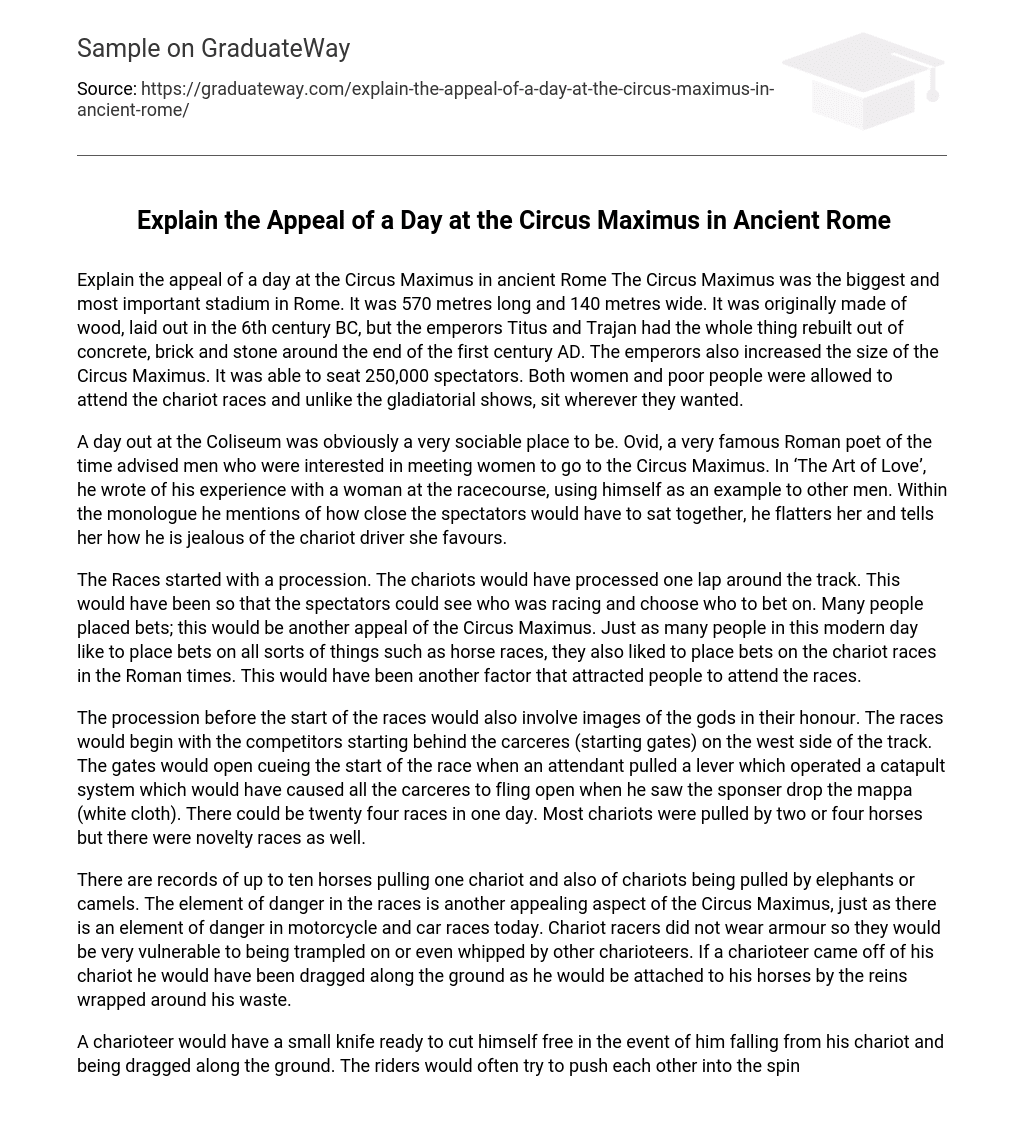Explain the appeal of a day at the Circus Maximus in ancient Rome The Circus Maximus was the biggest and most important stadium in Rome. It was 570 metres long and 140 metres wide. It was originally made of wood, laid out in the 6th century BC, but the emperors Titus and Trajan had the whole thing rebuilt out of concrete, brick and stone around the end of the first century AD. The emperors also increased the size of the Circus Maximus. It was able to seat 250,000 spectators. Both women and poor people were allowed to attend the chariot races and unlike the gladiatorial shows, sit wherever they wanted.
A day out at the Coliseum was obviously a very sociable place to be. Ovid, a very famous Roman poet of the time advised men who were interested in meeting women to go to the Circus Maximus. In ‘The Art of Love’, he wrote of his experience with a woman at the racecourse, using himself as an example to other men. Within the monologue he mentions of how close the spectators would have to sat together, he flatters her and tells her how he is jealous of the chariot driver she favours.
The Races started with a procession. The chariots would have processed one lap around the track. This would have been so that the spectators could see who was racing and choose who to bet on. Many people placed bets; this would be another appeal of the Circus Maximus. Just as many people in this modern day like to place bets on all sorts of things such as horse races, they also liked to place bets on the chariot races in the Roman times. This would have been another factor that attracted people to attend the races.
The procession before the start of the races would also involve images of the gods in their honour. The races would begin with the competitors starting behind the carceres (starting gates) on the west side of the track. The gates would open cueing the start of the race when an attendant pulled a lever which operated a catapult system which would have caused all the carceres to fling open when he saw the sponser drop the mappa (white cloth). There could be twenty four races in one day. Most chariots were pulled by two or four horses but there were novelty races as well.
There are records of up to ten horses pulling one chariot and also of chariots being pulled by elephants or camels. The element of danger in the races is another appealing aspect of the Circus Maximus, just as there is an element of danger in motorcycle and car races today. Chariot racers did not wear armour so they would be very vulnerable to being trampled on or even whipped by other charioteers. If a charioteer came off of his chariot he would have been dragged along the ground as he would be attached to his horses by the reins wrapped around his waste.
A charioteer would have a small knife ready to cut himself free in the event of him falling from his chariot and being dragged along the ground. The riders would often try to push each other into the spina and there were also lots of crashes against the meta (columns) which the chariots had to turn sharply around. Romans idolised teams in chariot racing in a similar way that people today idolise football teams. People who supported certain teams or fractions would usually sit together in support of their favoured charioteers and cheer wildly.
Often they would quarrel with supporters of other teams and spmetimes fights would break out. The atmosphere of the crowd would have been very loud and exciting, another engaging aspect of the Circus Maximus. There were lots of reasons that romans would have gone out to the Circus Maximus to watch the races; to socialise with the many other people who attended the races, to support their favourite teams and to marvel at the wonderful building and the skill of the racers and animals. I believe that if I was living in these times, I too would have very much enjoyed a day at the Circus Maximus.





